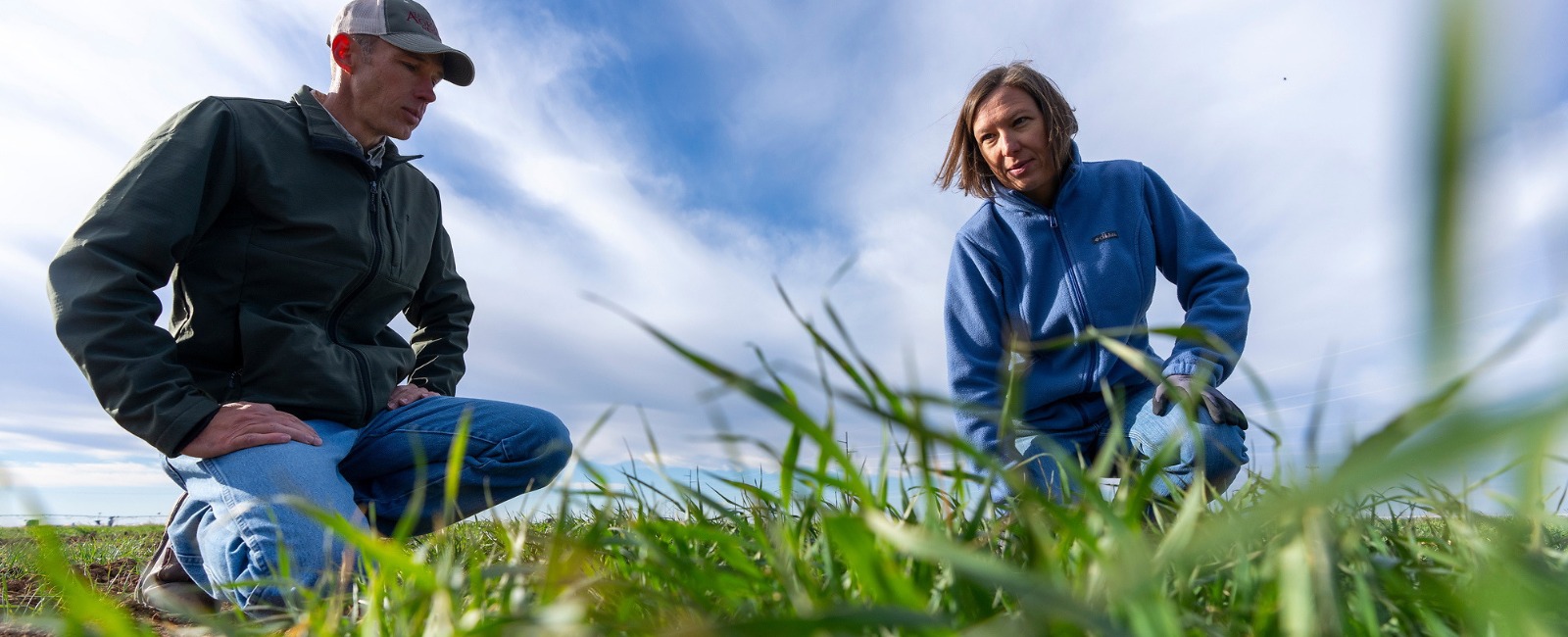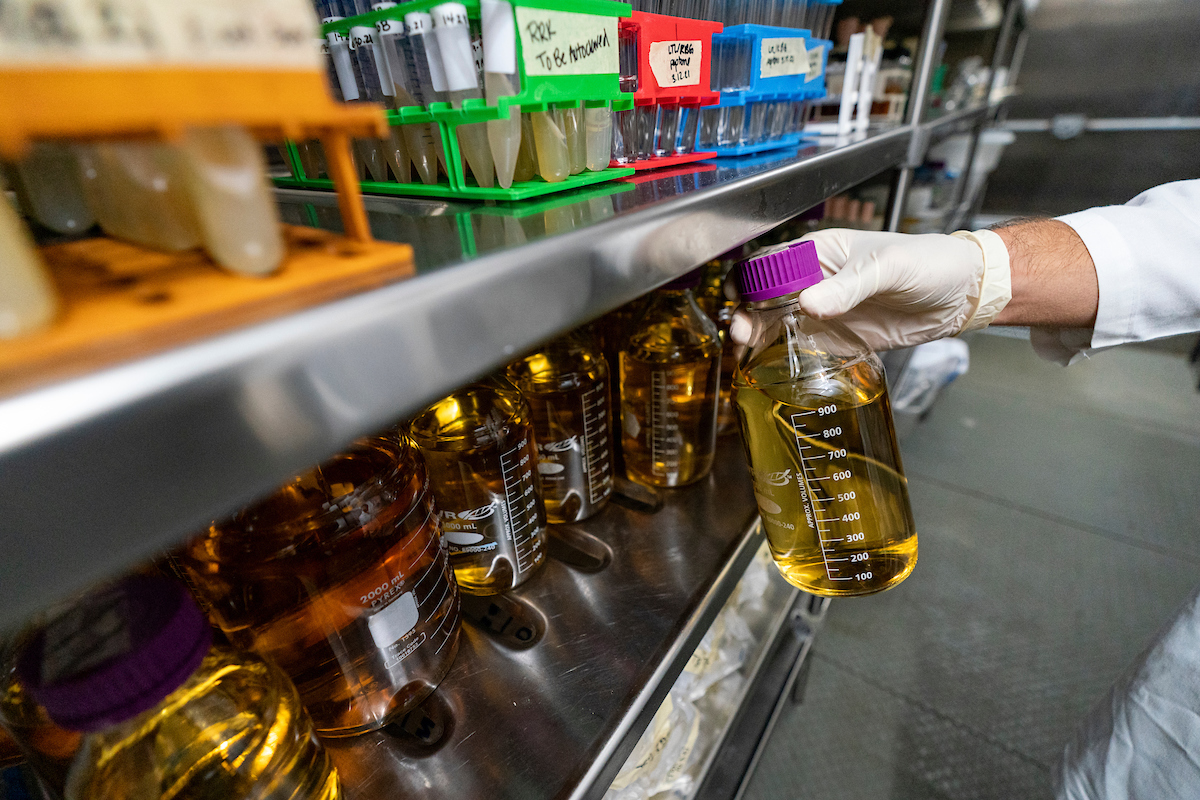
Texas A&M AgriLife Wheat Improvement Program
Adding value to wheat from genetics to consumers
Research for Improving Texas Wheat
Since it began in 1958, the Texas A&M AgriLife Wheat Improvement Program has served the people of Texas and beyond. Through the land-grant university system, our program has the unique ability to:
- Provide an integrated approach to developing broadly adapted/adopted hard red winter wheat varieties.
- Utilize classrooms, laboratories, and field plots to educate the next generation of scientists who will move the wheat industry forward.
- Share our knowledge with the producer and, as a result, benefit the consumer.
Our improvements to wheat varieties and management practices have increased Texas yields from 11 to 40 bushels per acre, thus increasing the food value from about $330 per acre to $8,000 per acre. Our research has led to varieties with improved insect and disease resistance, excellence in milling and baking qualities, and improved adaptability and forage performance. We have made great progress, but we will need to adapt our program to a changing environment if we are to continue feeding a growing world population. Meeting this challenge will require ongoing funding.
Key TAM Wheat Varieties
- Tascosa, 1958*
- Sturdy, 1965*
- TAM W-101, 1972*
- TAM 105, 1978*
- TAM 107, 1984*
- TAM 111, 2002*
- TAM 112, 2005*
- TAM 114, 2014
- TAM 204, 2014
- TAM 115, 2019
- TAM 205, 2019
*Planted over 1 million acres across the U.S. Great Plains in any single year
Learn more about our work to find the best new wheat varieties; train the next generation; educate producers; manage for grain and grazing; improve bread quality; and develop new technology for improving Texas wheat.
Finding the Best Varieties
The Texas A&M AgriLife Wheat Improvement Program is organized into two Centers of Excellence, each conducting variety development, basic genetic studies, and development of best management practices for wheat. The Amarillo Center targets rain-fed and irrigated production in the drier areas of the state, common to the High Plains and Rolling Plains of Texas. The College Station Center targets the more humid regions of the state, including South Texas and the Texas Blacklands. The two centers work together to develop some of the most widely grown varieties in Texas and across the Great Plains. In 2012, TAM wheat varieties were planted on 41% of Texas wheat acres, 20% in Kansas, 14% in Nebraska, and 11% in Colorado. Currently, the most popular wheat varieties released under this team are TAM 111, TAM 112, TAM 114, and TAM 204.
Managing for Grain and Grazing
Helping producers manage yield and quality of wheat forage and grain are priorities of the wheat improvement team. Yield and quality can be damaged by weather stresses, overgrazing, nutrient deficiencies, and pests. Management in the High Plains includes winter grazing of wheat by stocker cattle. The dual-purpose aspect of wheat increases management flexibility and helps stabilize economic income in areas with fluctuating climate and yields. Proper management decisions are more important than ever with today’s low profit margins.
Using Technology for Faster Development
AgriLife Wheat genetic scientists are reducing the time to develop improved wheat varieties through marker-assisted selection, doubled-haploids, gene editing, and genomic selection. On another front, Texas A&M’s Unmanned Aerial Systems Project is providing a new perspective to help wheat farmers manage diseases and water stress, predict yield in crop-breeding programs, and measure livestock forage production. These new
tools can unlock solutions that help farmers become more sustainable and increase profitability.
Training the Next Generation
The Soil and Crop Sciences Department in Texas A&M University’s College of Agriculture and Life Sciences is one of the largest such departments in the nation. Students are trained by world-class faculty in the classroom and the field. In partnership with Texas A&M AgriLife Research and the Texas A&M AgriLife Extension Service, these students gain research experience and are able to help transfer that new knowledge to the public.
Educating Producers
Field days are classrooms for producers. AgriLife Extension educational programs in wheat rely heavily on field demonstrations of new technologies, including seed treatments, weed control, forage and grazing management, pesticide and herbicide resistance, and agronomic management practices including planting dates, seeding rates, and nutrient management.
Improving Bread Quality
Wheat is the most popular human food crop in the world. This presents an ideal opportunity to improve the nutritional quality of bread and tortillas, the primary products made from Hard Winter Wheat. Research at the
Texas A&M Cereal Quality Laboratory ensures that TAM wheat varieties have the milling and baking qualities that the food industry needs and the health benefits that consumers demand.
Faculty

Jackie Rudd, Ph.D.
Wheat Breeding Project Leader, Texas A&M AgriLife Research, Regents Professor of Agronomy, Texas A&M Department of Soil and Crop Sciences
Publications

Find a complete listing of research publications by Dr. Rudd’s lab at TAMU Scholars online
